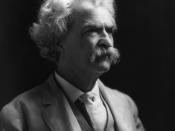Twisted Vision Before William Sydney Mount focused his artistic talent on black Americans, they were considered primarily comic figures within the art world. It was considered permissible to use them either in the background either as musicians or as eternal court jesters but never as human beings. They were characters without being, stereotypical icons reinforcing the general public's negative sentiment of black Americans. William Sydney Mount helped to change that view of black Americans through some of his paintings. He was the first American painter that used them as the actual subject of his painting. His paintings were created at the beginning of a slow painful change within the country, and the repercussions of the changing of the United States from a slave-owning culture to a more "ÃÂperfect' democracy are still being fought over today. His paintings, such as Farmers Nooning and The Bone Player, although they still contain what we would consider problematic type casts as twentieth-century readers, begin to bring the black American out of caricature and into "ÃÂfine' art.
In a letter to William Schaus written on Sept 9, 1852, a representative of the Goupil, Vibert & Company, as well as a friend, Mount says, "A Negro is as good as a white man --as long as he behaves himself." Although Mount was pro-slavery, he no longer considered blacks just the butt end of jokes, considering them worthy models of high art. Mount is caught in a cultural battle within which he does not want to be. Being caught in a time period where racism is the norm and not the exception, he produces works in which the viewer cannot help but identify with the black characters. His work was the first step in breaking the stereotypes placed on blacks by the white majority. The realistic portrayals of blacks and his focus on blacks in some of his paintings give viewers for the first time, representations of black characters which were free of most stereotypical elements and more true to reality than anything produced earlier in America. William Sydney Mount does not escape entirely from the racism of his time period but thorough his paintings he does succeed in portraying realistic Afro-American characters which become the focus of the painting..
Mark Twain's vision is similar. He writes using racist language and puts Jim, the main black character, into a number of degrading situations that call into question Jim's intelligence, as well as his function within the book. But at the same time he also gives the reader a powerful, emotional character in Jim, one who is moral, trustworthy and at times, wise. Growing up surrounded by slavery, Twain was so deeply rooted in the racist culture that he not only could not be separated from it but he didn't want to be separated from it. Peaches Henry in her article, The Struggle for Tolerance: Race and Censorship in Huckleberry Finn, effectively argues that Twain "he accepted slavery while growing up [and] [l]eaving slaveholding Missouri seem[ed] to have had little effect on his racial outlook... " Twain's perceptions of blacks were ingrained into him early in his life and although later in his life slavery was no longer an institution in the United States, he still felt superior to black in some ways while at the same time trying to help them along. His world was a world in which blacks were always present and the descriptions in the book concerning Jim waver back and forth between the minstrel comedian and a thoughtful father figure reinforce this idea. But instead of being contradictory, these descriptions explain the true fiber of the way life was in the America of the 1800s. The discontinuities that Twain builds into Huck Finn concerning blacks give the reader another perspective of reality, in which slaves are the norm and acts of cruelty and kindness toward them are everyday occurrences.
William Sydney Mount and Mark Twain both grew up in a world before the Civil War, where slaves were a reality. They both saw blacks as "inferior" to whites in many ways but they both also saw their humanity. A reason for this may be the fact that they both grew up with blacks all around, allowing them to see the way blacks were treated by their elders but also seeing the way in which they were treated by the blacks. Both Mount and Twain give us strong arguments for the humanity of blacks while at the same time parodying their subject in other ways. This duel role that is played by blacks in both Twain's and Mount's works are not just coincidences but rather a cultural standard.
In Mount's Eel Spearing at Setauket (Fishing Along Shore), a reader cannot help but feel the power resonating from the black woman in the painting. She is a strong powerful woman, who is very much in control of herself, which is suggested by the fact that she is standing in a very small boat with one foot braced on a gunnel. The woman takes over the painting, leaving the small white boy in the boat to become a secondary character. Mount's depiction of her breaks several stereotypical boundaries and gives her a dignity that had never before been afforded to a black in American art. She is not portrayed as lazy or unintelligent but on the contrary she is seen concentrating on her fishing and is the definitive authority within the painting.
Her tools are not carelessly left about, as Mount portrays in some of his earlier and later paintings, but she grips the spear with determination and skill. She stands poised against nature in this ancient battle and she seems very capable.
Mount portrays her in an extremely realistic manner, dropping the stereotypical caricatures that were prevalent at the time. Because he is the first person to paint blacks realistically in the United States, not to mention black women, we see him as a heroic figure breaking the boundaries of cultural stigmatisms, whereas in actuality, he was representing a moment in his life in which he learned to fish for eels. The significance of the painting, for Mount, was not to represent blacks in the community, it was to represent rural reality. The power with which he paints the women far surpasses the stereotypical representations of blacks up to this point within American art and although this is a step forward in the representation of blacks and the painting is obviously dominated by the black woman, the painting's agenda is neutral. The conflict in the painting in no way impinges upon or challenges the roles of the woman or the boy, it is strictly a conflict with nature and a benign nature at that. She is a trusted person, given the role of protector, mother and provider to the boy as they fish far from other people but it is a scene which is not meant in anyway to be threatening to the viewer.
Mount has given the reader a "ÃÂslice of life' within which everyday transactions between whites and blacks can be seen. Mount imbues her with the humanity she deserves but at the same time not letting go of his racist viewpoints. The woman becomes charged with energy in more than one way because of this for us as twentieth-century readers. This woman is clearly portrayed in a function which would have realistically been a role for a black in the 19th century. He drops the caricature but the bigotry inherent in his remains. Mount actually went eel fishing when he was young with a black man. The "ÃÂslice of life' that we receive from Mount is one distorted most likely by social pressures which were not sympathetic to blacks, because his recollection of this account in a letter to Charles Lanman, dated November 17, 1847, he gives a very positive image: "To those wishing exercise for their health the spearing of fish has the advantage over all others. I have derived great benefit from it. An old Negro by the name of Hector have me the first lesson in spearing flat-fish, and eels. Early one morning we were along shore according to appointment, it was calm, and the water was as clear as a mirror, every object perfectly distinct to the depth from one to twelve feet, now and then could be seen an eel darting through the sea weed, or a flatfish shifting his place and throwing the sand over his body for safety. "Steady there at the stern," said Hector, as he stood on the bow (with his spear held ready) looking into the element with all the philosophy of a Crane, while I would watch his motions, and move the boat according to the direction of his spear. "Slow no, we are coming on the ground," --on sandy and gravelly bottoms are found the best fish. "Look out for the eyes," observes Hector, as he hauls in a flat fish, out of his bed of gravel, "he will grease the pan my boy," as the fish makes the water fly about in the boat. The old Negro mutters to himself with a great deal of satisfaction, "fine day, not a cloud, we will make old mistress laugh, now creep --in fishing you must learn to creep," as he kept hauling in the flat-fish, and eels, right and left, with his quick and unerring hand. "Stop the boat," shouts Hector, "shove a little back, more to the left, the sun bothers me, that will do, now young Master step this way. I will learn you to see and catch flat-fish...." Mount's letter is filled with excitement and power as he explains the situation. It is a scene which has obviously meant a lot to him and one which inspire his painting, Eel Spearing at Setauket (Fishing Along Shore) but at the same time he cannot paint the black character as a man possibly because it might have created a more powerful image of a black male than the public would have been readily accepted so he changes his experience and Hector becomes a woman. Twain also finds himself living within the same set of social values as does Mount thirty years earlier. Twain started Huck Finn in 1876, twelve years after the emancipation of the slaves, but his ideas concerning blacks were still those of many whites. In Huck Finn, Twain's racism is evident throughout the book. It becomes a law of nature within the story. To Huck slavery is such a deeply ingrained institution that he feels guilty for helping Jim escape. He sees slaves as property of people that, "belonged to a man I didn't even know; a man that hadn't done me no harm. " Despite the fact the language used is derogatory to us concerning blacks, at the time the phrase "ÃÂnigger' did not have as negative a meaning as it does today. Huck is not continually cursing Jim by his use of the term, he is only using it as a defining term. He "ÃÂknows' they are separate from his "ÃÂculture' in some ways but he cannot quite pin down how they are different.
Twain weaves us through the stereotypical images of blacks, as he puts Jim into the roll of a superstitious, at times lazy and dumb minstrel figure, one which is the butt end of the jokes of both Huck and Tom for a large part of the book. But he also gives us a heteroglossic figure in Jim by forging Jim into a strongly emotional, hard-working figure within the text. The two separate readings can both be supported by the text and I would argue that they are both meant to be in place. Jim as the minstrel character is cajoling the old stereotypes of the time period, while Jim as the emotional character takes the reader away from the "ÃÂhumor' and further into the complexities of black/white relations.
Peaches Henry in her article The Struggle for Tolerance: Race and Censorship in Huckleberry Finn, states, "These early renditions of Jim serve more to lay bare Huck's initial attitudes toward race and racial relations than they do characterize Jim, positively or negatively. As the two fugitives ride down the Mississippi deeper and deeper into slave territory, the power of Jim's personality erodes the prejudices Huck's culture (educational, political, social and legal) has instilled." The minstrel character becomes a tool with which Twain shows us the multifaceted relationships between blacks and whites. At this time blacks are still perceived as inferior in all official capacities but they are equals emotionally.
William Sydney Mount and Mark Twain both work toward the portrayal of this conditional equality, an equality which secrets itself in the streams and eddies of emotion. Most importantly they both felt strongly enough about this "ÃÂequality' that they both used their venues to describe it. Mount in his painting gives us the first strong, powerful, and thoughtful characters in American art, while Twain gives us a similar character in Jim. They both give black Americans a new cultural dignity which up until this point had been refused them. They receive a voice in a world, which up until that point, had confined them to the world of caricature. Both Mount and Twain start the process of raising the dignity of black Americans but their cultural limitations stop them from completing the job.





